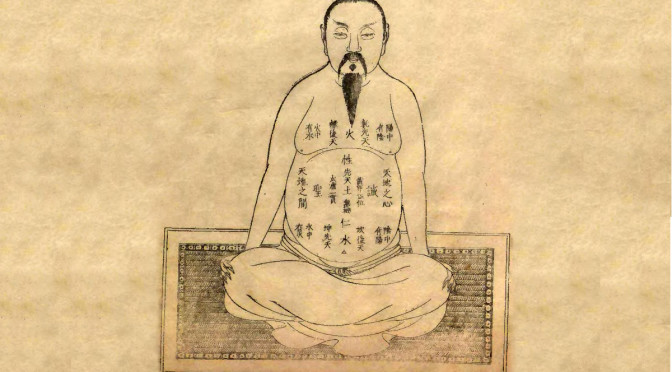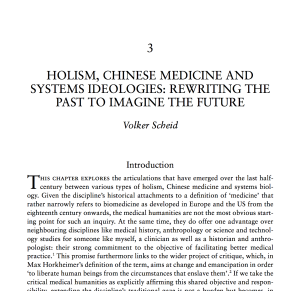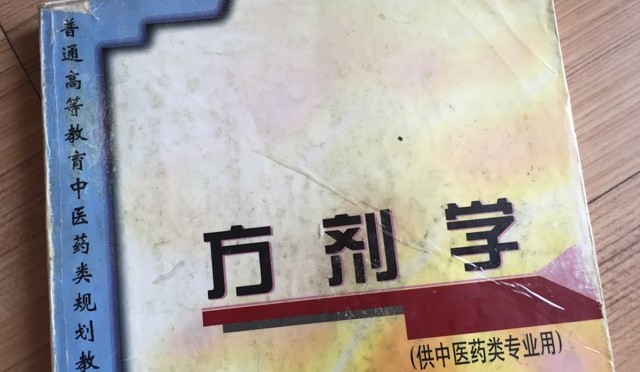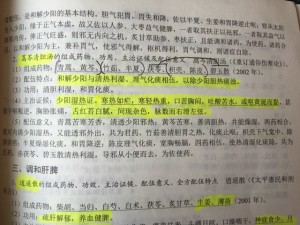Sharon Hennessey, DAOM, L.Ac.
Dr. Hennessey is Domain Chair of the Acupuncture Department at ACTCM @ CIIS with an interest in acupuncture research. She has published several articles in CJOM, and recently presented a poster at SAR’s Conference in 2015 and 2017. Her posters and articles can be viewed at sharonhennessey.com.
Abstract:
The concept of therapeutic alliance, i.e., the relationship between practitioner and patient, is identified as being historically rooted within the practice of traditional Chinese medicine. Within this context, this relationship is shown to serve the modern self — a recent construct favored in westernized industrial countries. While tracing the rise of the modern self, the value and limitations of this construct are evaluated.
In this essay both the acupuncture intake, comprised of ten questions, and the practice of the Chinese self-cultivation techniques are analyzed: the intake procedure as an effective therapy and practitioner self-cultivation as a source for patient inspiration. By re-appropriating archaic methods, Chinese medicine practitioners can guide patients in the formation of a valuable personal narrative to address a construct of modernity.
Key words:
acupuncture narrative, human potential, Yang Sheng self-cultivation.
An Archeological Discovery
Ancient Chinese culture may have eschewed the individual, but in the practice of Chinese medicine there has always been an emphasis on treating idiosyncratic pathologies, unique to each person. Elisabeth Hsu, in chapter 2 of Innovation of Chinese Medicine, describes twenty-five such medical case histories found in the biography of a Han doctor recorded in about 90 BC. Hsu asserts that illness was designated by the term bing rather than the term ji. Her investigation revealed that apart from other meanings, bing frequently referred to the emotional state of a distressed or aggrieved person, suggesting that bing referred to the mind-emotion-body complex.1 This concept of individualism, buried in Chinese medicine, functioned as a release valve for strictures in traditional Confucian culture, indicating a nod to the individual through pathology.
By using this strategy today, the modern acupuncture practitioner may covertly treat a wide range of disharmonies that effect the psychological or metaphysical through the medium of the physical body.
Evolution of the Modern Self
Once upon a time we were all part of a family, congregating within a community or tribe, bounded by rules and traditions that guided every aspect of our lives. But industrialization and other extraordinary successes of capitalism eventually managed to devastate these traditions and erode our connection with the past.
As now experienced, the concept of self is a unique and recent construct that has emerged in the past century, launching each individual on a quest for personal meaning that had been previously supplied by traditional communities. Add to that the Nietzschean demise of the creator, the startling new world of physics, and the material excess of capitalist production, there emerged from the divan of Sigmund Freud and other psychologists a new kind of self. In the BBC documentary, Century of the Self, Adam Curtis examines how we have moved from the ‘citizens with needs’ to ‘consumers with desire’. In this documentary, Curtis deconstructs how the Freudian concept of ‘unconscious’ desire was harnessed to the new business of marketing consumer goods, encouraging the emergence of a singular individual. This new self re-examined the constraints that had previously bound it to the precepts of religion and other dogma.
Jan Sloterdijk’s You Must Change Your Life describes our “withdrawal from this collective identity” as a directive demanding that all individuals must now stand beside themselves a priori, living their lives in front of the mirror, or function as actors of everyday life.2 He decrees that we were once part of a collective unity, bounded by religion, tradition, and family that functioned as additional immune system by guiding, signifying, and protecting us.2 Now, with only our self-created psyche to protect or direct us, humanity must face the numerous onslaughts of circumstance alone.
Christopher Macann states: “Ontological psychology ceases to be what Kant took it to be: a spurious deduction of the immortality of the soul from the principle of self-identity”3, and becomes instead what might be called a doctrine of self-actualization, a phrase made famous in Maslow’s Psychology of Being.”4 Maslow describes self-actualization as “….what a man can be, a man must be…It refers to the desire for self-fulfillment, namely, to the tendency for him to become actualized in what he is potentially. This tendency might be phrased as the desire to become more and more what one is, to become everything that one is capable of becoming.”5
Authoring the Self or How to Live a Meaningful Life
The self has now become a center for experimentation and authorship. For a meaningful life, experiences must be accumulated and curated, and the personal narrative becomes a centerpiece for communication. Individual stories serve as guideposts for inspiration and transcendence in much the same way as The Confessions of Saint Augustine did 1700 years ago.2 Self-involvement is not new to western history, but it was traditionally used to serve as an example at the demand of some greater authority. Augustine’s Confessions are an early version of a transformational life story that permeates Hollywood dramas and soaps.
For the multitudes, the self-portrait, particularly illustrated by Rembrandt’s more than 90 painted images of himself, is now the “selfie”—a self that is not under the control of some special aegis. It is especially unsettling to many social critics, who claim it is a short jump from selfie to selfish. Great moral opprobrium is attached to this concept of self. Critics see self-involvement as shedding important shared traditions that have served to organize people or, in a spiritual context, preferring the self to the creator or the originator of that self. But this new self, while, yes, prideful and actively undermining tradition, still requires tending and guidance.
Jumping forward to our new, service-oriented economy, many kinds of practitioners are now engaged in mapping the ontology for this new individual self through the medium of the personal narrative. This new self has spawned a huge service industry that caters to its development, refinement, and care. This is important because other cultural institutions that once cultivated, sheltered, and groomed this aspect of our psyche are in retreat.
The Chinese Medicine Intake: The Practitioner Helps the Patient Write a Narrative
In my own specialty, acupuncture, the patient is encouraged to build their personnel narrative based on the ten intake questions, which provides an organizational template for their story. As the patient describes their digestion, sleep patterns, urination, breathing, and any other subjective sensations they may wish to include, these ten questions serve as a type of somatic confessional, whereby the patient is able to transpose their psychological and metaphysical anxiety into simple and comprehensible evaluation of autonomic vegetative functions. Rather than the soul or psyche, these functions then become the object of transformation. By the simple principle of adjusting the flow, intake, and expulsion of fluids, gases, and solids, the individual can be tuned to perform at a higher level.
In a secular world there is the obvious benefit to only adjudicating somatic function. Many pejorative moral and psychological implications can thus be averted, while such vegetative functions are modified or streamlined to a superior level of performance.
This strategy of using Chinese medicine to treat the somatic body by addressing the psyche is oddly akin6 to the James-Lange Theory of Emotion. This theory was put forth in 19th century initially by American psychologist and theosophist William James and later, separately, by Danish physician Carl Lange. In this theory, physiological changes actually precede emotions. The subjective emotion is experienced because of the underlying physiology: our autonomic nervous system generates the physiological events that we associate with an emotion such as heart rate, perspiration, dry mouth, muscular tension. This theory suggests that emotions are a result of physiology rather than the cause.6 The autonomic nervous system is primarily unconscious, associated with activating the flight or fight response. But new research also shows that the sympathetic nervous system is “part of a constant regulatory machinery that keeps body functions in a steady state equilibrium.”7
It has been recently demonstrated that the sympathetic nervous system and the hypo-pituitary axis are activated by antigenic activity. Local immune cells inform the central nervous system and vice versa; the door swings both ways. New research in bioelectronics suggests that inflammation can be suppressed by stimulating the vagus nerve with electrical impulses. The standard of care associated with inflammatory conditions, such as rheumatoid arthritis, Crohn’s disease, or other insidious autoimmune conditions, might very soon incorporate vagal stimulation. Increasing vagal tone can also be taught by using the biofeedback technique.8,9 Hence, research science is verifying that the underlying soma is an effective pathway to modulate the psyche and vice versa.
In a study (to be published) by Randy Gollub et al., a patient’s experience of pain relief was correlated to their perception of being cared for with empathetic understanding. Patients were asked to evaluate the level of interest shown by their practitioner. Results demonstrated that their pain relief was enhanced by practitioner empathy. 10
A trial designed by Ted Kaptchuk, presents the notion that the patient’s narrative about self is fundamental to their health. He discusses and demonstrates how a practitioner perceives a patient affects the outcome of their health.11 This study of patients with irritable bowel syndrome randomly divided them into three groups. Group one was put on a waiting list. Group two received placebo treatment from a disinterested clinician. The third group got the same placebo treatment from a clinician who asked them questions about symptoms, while describing the causes of irritable bowel and displaying optimism about them overcoming their condition. Not surprisingly, the health of those in the third group improved the most.
The Golub and Kaptchuk studies demonstrate the value of practitioner involvement. In recording the patient’s subjective narrative, practitioner empathy becomes part of substrate that influences the acupuncture patient’s outcome.
Acupuncturists stress which foods to eat, the temperature of the food to be consumed, how much to drink, what to drink, when to sleep, when to rise, how to dress, how often to have sexual intercourse, or how to massage internal organs. For patients who have never observed their bodily functions, discovering that the shape of a stool or the color of urine or nose phlegm can be a window into the interior can have profound effect on self-reflection. In a secular world, Chinese medicine provides support and instruction similar in some ways to the dietary and lifestyle guidelines once administered by other belief systems.
The acupuncture intake and diagnosis that generates this personal narrative with its pastiche of authentic Taoist and Confucian phrases represents an antique system of healing. This also can function successfully today as an intact nonreligious construct for evaluating the pilgrim/patient’s transcendent progress on their journey with their self, stressing behavior over belief.
Evolution of Self–Cultivation
For Maslow, levels of self-actualization are the peak levels achieved by an individual. Often an evolved individual can by example pull the rest of humanity upward toward a higher level of proficiency or consciousness.
In his essay, The Neurology of Self-Awareness, Ramachandran suggests that mirror neurons have played a critical role in learning through imitation rather than trial and error, along with our strong ability to empathize. He proposes that extraordinary human progress, in which self-awareness is fundamental, is the result of the interplay of these mirror neurons.12 He also posits that because of mirror neurons, humans have the uncanny ability to imitate each other and understand each other’s feelings, “setting the stage for a complex Lamarckian or cultural inheritance that characterizes our species.”12
Rizzolatti discovered back in 1996 that mirror neurons are the pre-motor neurons that fire when a primate performs some object-directed actions, such as grasping, tearing, manipulating, or holding but also when the animal watches someone else perform the same actions.13
Additionally, it is not just the repetition of one but repetition of many, imitating and competing, that drives us forward. Take the simple example of the marathon: in 1921, best time was 3 hours and 18 minutes; in 2014, best time was 2 hours, 2 minutes and 57 seconds.14 This has been achieved over the span of many years, through the accumulated effort of many runners, competing against each other, and shaving the time, second by second, year by year. Each competed to be the best, inspired by and imitating the competitor whom they followed, and tended and coached by those who made running a practice.
This sort of consciousness-raising effort that pervades human behavior is described by Jan Sloterdijk in You Must Change Your Life. He lauds the Nietzschean doctrine of combining practice with cumulative knowledge or education and designates practicing and training as an original and uniquely human path, especially in seeking to transcend the self.2 Through Sloterdijk‘s lens, training, peak experiences, and performance crystallize the human experience, while conscious measurement, observation, and skill refinement are reflected in learning and practice.
Sloterdijk comments that such training and practice systems formed the core of Platonism, Brahmanic training, and Taoist alchemy and martial arts, guiding adepts up ‘the vertical wall of achievement’ in superhuman spiritual and athletic extremes that have shaped the image of what human potential can be.2
Chinese Practice and Self-Cultivation
In ancient China, Taoism embraced the belief that through breath and meditation they could transform their lives, by reaching for immortality. Joseph Needham describes how in ancient China the physiological alchemists believed they could “master their neuro-muscular coordination, and sexual activity as part of the Tao.”15 He describes such activities, listing how this was accomplished by employing respiratory exercises, counting heartbeats, experiencing the movement of inner qi, and using a myriad of other special techniques, which were designed prolong longevity or restore youth by internally transforming the practitioner.15 These early Taoists exercises evolved into complicated styles of self-cultivation.
During the early Han period, around 200-100 BC, medical understanding of the inner body was changing. By the time the Huang de Nei Jing was compiled, there was a formal system of channels known as the jing luo, which allowed different types of qi to circulate.1
Medical technology was also changing. Fine filament needles became the preferred method of treatment.16 The practitioner was guided by the Su Wen and Ling Shu on how to perform this new inner practice. He was encouraged to gather his qi, employing techniques of self-cultivation that acupuncture students are still taught to imitate today. Metaphors in the Su Wen, such as “use the hand as if holding a tiger” or “pouring over a deep abyss,” coach the practitioner on how to proceed in treatment.
Technique was conflated with rectitude and moral character, instructing the practitioner to influence the spirit of the patient or proceed to a deeper metaphysical exchange, using the needle as an instrument of transmutation.16 These special skills represented the fruits of self-cultivation for the practitioner.
By focusing on self-manipulation of qi and self-improvement in technique, acupuncturists have become default practitioners of Yang Sheng self-cultivation
skills.1 Modern Chinese medicine has become an odd mix of the esoteric internal practice methods combined with modern physiology. By simply reading through a list of continuing education courses or the advanced curriculum at institute of traditional Chinese medicine, this obsession with obscure Taoist practices can easily be verified.
Pursuing a practice under the guidance of a Chinese master, whose particular lineage defines their curriculum vitae, is the equivalent to pursuing a board certification in another profession. Even if personally refraining from a deliberate practice of self-cultivation, acupuncture students are exposed to such practices through curriculum requirements. It is inculcated in the rhythm of learning in a professional school, where either qi gong or tai chi are combined with esoteric poetry about nature.
It is normal to find a student of acupuncture involved in a deep meditative performance exercise such as tai chi. Mastery of practice-related performance is expected of these students. In this profession, self-cultivation and skill development go hand in hand; other medical professionals are not expected to harmonize their qi, learn mystical movements such as tai chi, or root their being, before interacting with their patient. The skills of self-cultivation as both a healing art and a moral virtue are embedded in Chinese medicine. This imbues the practitioner with leadership qualities that occur in other training modes such as sports, arts, or religion. The modern patient, typically lacking in ritual signifiers for lifestyle direction, can thus benefit from this personal example of their practitioner.
Conclusion
Western treatments based on statistical patterns and board declarations that direct standards of care often negate or ignore an individual’s metaphysical sense of being. In the context of eastern and western cultural norms, western culture employs treatment standards that are ironically more aligned with the statistical whole, whereas traditional Chinese medicine, aligned with a rigid Confucian social structure, embraces the individual. In this example of cultural syncretism, acupuncture offers the modern self the care and understanding that it currently lacks in the territory of western evidence-based treatment.
Despite being anchored in traditional principles of Taoist and Confucian philosophy, Chinese medicine is able to address the modern concept of self by creating a distinct diagnostic template for the treatment of each patient. This narrative template teaches individuals to observe and measure their soma in a practical, effective way against an intact system that encompasses philosophical underpinnings that reflect every aspect of patient behavior. It is composed of understandable natural metaphors that generally resonate well with the patient and can be transposed into simple behavioral modification.
As part of traditional culture, both the narrative and techniques of self-cultivation are able to furnish individual guidance and performance-activated behavior that are often lacking in both western therapy and modern cultural norms. When scientists try to evaluate the efficacy of the acupuncture treatment, they often fail to comprehend the value of these methods: the intake, which varnishes the diagnosis with a veneer of empathy, and examples of self-cultivation, which represent internal strength achieved through moral refinement. Together, these two essential components of an acupuncture treatment may contribute monumentally to a therapeutic alliance that successfully enhances the patient’s outcome.
References:
- Ed. by Elisabeth Hsu, Innovation in Chinese Medicine, Needham Research Institute, Cambridge University Press, 2001; p. 16.
- Peter Sloterdijk, You Must change Your Life, Polity Press; 2013. pp. 211, 215, 322, 199.
- Referring to the Cartesian Objective
- Maccan, Being and Becoming: https://philosophy now.org/issues/61
- A.H.Maslow (1943); A Theory of Human Motivation, Originally published in Psychological Review, 50, p.370-396. http;//psychclassics.yorku.ca/Maslow/motivation.ht
- https:Wikipedia.org/wiki/James-Lange_theory
- http://medscape.com; Medscape: Arthritis Research & Therapy; Georg Pongratz; Rainer H Straub; The Sympathetic Nervous Response in Inflammation.
- http://www.newyorktimes.com: Michael Beharmay, Can the Nervous System Be Hacked?; Mar. 23, 2014.
- Torres-Rosas R, Yehia G, Peña G, Mishra P, del Rocio M, Ulloa L, et al. Dopamine mediates vagal modulation of the immune system by electroacupuncture. Nature Medicine. 20, 291–295 (204) doi:10.1038/nm.3479
- Mawla I, Gerber J, Delibero S, Oriz A, Protsenko E, Gollub R. Oral Abstract, Therapeutic Alliance between Patient and Practitioner Is Associated with Acupuncture Analgesia in Chronic Low Back Pain, Society for Acupuncture Research, 2015 Conference program, Boston, MA, USA, 11/12-13, 2015 , #SAR2015.
- T J Kaptchuk; Components of placebo effect: Randomised controlled trial in patients with irritable bowel syndrome; BMJ.April2008;336:999 doi:10.1136/bmj.39524.439618.25.
- Ramachandran V. [1.1.09]; Conversation: (title) Mind; Self Awareness: The Last Frontier; E. edge.org.
- Marco Iacoboni, Istvan Molnar-Szakacs, Vittorio Gallese, Giovanni Buccino, John C Mazziotta, and Giacomo Rizzolatti; Grasping the Intentions of Others with One’s Own Mirror Neuron System; Published: February 22, 2005; DOI:10.1371/journal.pbio.0030079
- https:/www.wikipedia.org/wiki/Marathon;_world_record_progression
- Joseph Needam, Volume V, Science and Civilisation in China: Chemistry and Chemical Technology, Part 5, Spagyrical Discovery and Invention: Physiological Alchemy, Science and Civilisation in China, Volume V:5; Cambridge University Press,1985; p. XXVIII, Introduction., p. 29
- Vivienne Lo, Spirit of Stone: Technical Considerations in the Treatment of the Jade Body; Bulletin of the School of Oriental and African Studies, University of London Vol. 65, No. 1 (2002), pp. 99-128, Published by: Cambridge University Press on behalf of School of Oriental and African Studies; Stable URL: http://www.jstor.org/stable/4145903









 “Human milk.” Anon. Buyi Leigong paozhi bianlan (n.p, 1591), Book 8.
“Human milk.” Anon. Buyi Leigong paozhi bianlan (n.p, 1591), Book 8.

